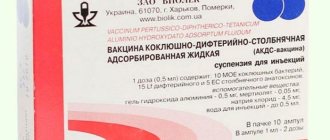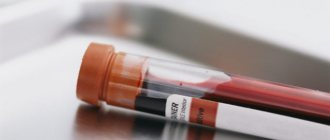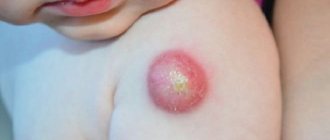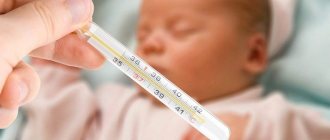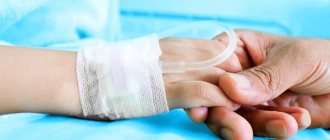Vaccination is a necessary measure. And this is the only way to protect your baby from various infections. And since any immunization is, in fact, an artificial (albeit small) infection, the child’s body is forced to fight it.
DTP vaccination is not the most pleasant procedure; moreover, it is a complex drug that protects against several diseases at once. Therefore, the immune system must “try” to cope with the infection. After DPT vaccination, redness is perhaps the most common reaction of the body to injected pathogens. But should we be afraid of this?
Red spot on the thigh after DPT vaccination: normal or complication?
DTP is the vaccination to which a small patient always reacts to varying degrees of intensity. The area where the vaccine is injected often turns red. A slight swelling may form. This is very frightening for parents, but only for those who do not distinguish a normal local reaction from a truly serious complication to the vaccine.
DPT vaccine
Redness at the injection site is not dangerous if it does not exceed 6-7 cm. Normally, it should be about 2 cm in diameter. Why does the skin turn red? This is the body’s reaction to artificial infection (and this is vaccination) with pathogenic microorganisms.
There are three of them in DTP: whooping cough, diphtheria and tetanus. This is a serious test for the baby's immune system, since it needs to produce antibodies for each type of pathogenic bacteria. Redness is evidence that the body has begun an “attack” on infectious elements. How to distinguish a normal reaction from a complication?
Observe the injection site. The redness should fade and disappear quite quickly - within 2-3 days. This is typical for inactivated vaccines (including DPT). And this is how they differ from “live” drugs, in which similar reactions occur after a week.
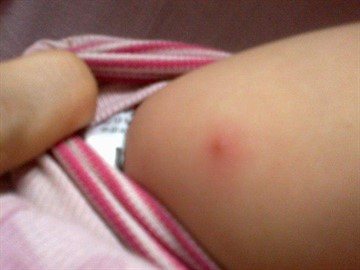
Redness and hardness at the injection site (according to statistics) are diagnosed in every 4th baby. This shouldn't scare parents. It is also important to know that such a reaction will be more pronounced with the 2nd and 3rd vaccinations.
This is understandable, because when DPT was introduced for the first time, the immune system was just beginning to “get acquainted” with pathogens and did not have time to develop protection in the form of specific cells - lymphocytes.
But with subsequent vaccinations, their number has already become sufficient to “repel” strangers - antigens. And outwardly this manifests itself in redness of the puncture site. But such a reaction is expected, because it indicates a “correct” immune response.
If the redness goes away in the first days after the injection, then we can assume that the procedure went “excellent”.
Clinical picture
During the injection process, a solution of aluminum hydroxide gel with killed pertussis germs and purified diphtheria and tetanus toxins is injected under the baby's skin to stimulate the immune system to respond to illness.
When the leg is swollen after DPT, this is considered a normal response of the body to the administered vaccine, and even vice versa, it is precisely such “adverse reactions” that signal that the suspension is working and the immune system is strengthening.
For some hours, the medicine is localized at the injection site, so at first the leg swells after DTP, but the area of redness should not be more than 3 cm. Otherwise, you should “sound the alarm” and consult a doctor! Young mothers should be especially attentive to accompanying symptoms. If after DPT vaccination the baby’s leg is swollen, the body temperature has risen, general weakness and drowsiness are observed. In this case, it is better not to treat yourself and get examined by a pediatrician.
Why does the injection site on a child’s leg become red, swollen and hard?
DTP is a complex vaccination.
Almost all kids respond to it. In addition to redness of the injection site, hardening or swelling may occur. This is often diagnosed after the introduction of Pentaxim. Not only the thigh where the drug is injected may become swollen and red, but also the entire leg.
There is no need to be afraid of this situation, since each child’s immunity is individual and copes with the infection to the best of its ability.
For this reason, one baby may experience severe redness of the skin, while another may not have it at all. But in any case, such symptoms are considered normal, since they confirm that the body has launched an “attack” on pathogenic organisms, forming a specific defense against them - immunity. And this is the goal of any vaccination.
Even if the injection site is red and swollen, but the baby steps on the leg - this is a normal reaction. You should only worry if the redness does not subside, but, on the contrary, increases in size, exceeding 7-8 cm in diameter, and the injection site swells and hurts.
If the baby has difficulty walking and limps, this is already a complication. What's going on? It's all about the slow resorption of the injected vaccine. Lameness will go away as soon as the infiltrate dissolves in the tissues. This may take 7-8 days.
If the swelling and redness are severe and the leg is hot to the touch, immediately show the baby to the surgeon. Don't treat yourself. Coordinate therapy with your local pediatrician.
Why does swelling occur at the injection site and should you be afraid of it?
The effect of the vaccine can affect the baby in different ways; some reactions are within normal limits. But parents should definitely pay attention to whether the entire leg is swollen after DTP or just the injection site.
We advise you to read: All about cystitis, swelling under the eyes
Swelling of the thigh area
Any specialist will tell you that there should be swelling, and even severe redness, at the injection site. A bacteriological drug has been introduced into the body, and the immune system has to react to it. But if the vaccination site is not swollen, then this indicates either very strong immunity, or, conversely, its apathetic functionality. But here it should be remembered that only a small tumor up to 3 cm in diameter is considered normal. A lump within 3-8 cm indicates non-compliance with the doctor’s instructions and is also not dangerous, but if it is large, you need to consult a doctor.
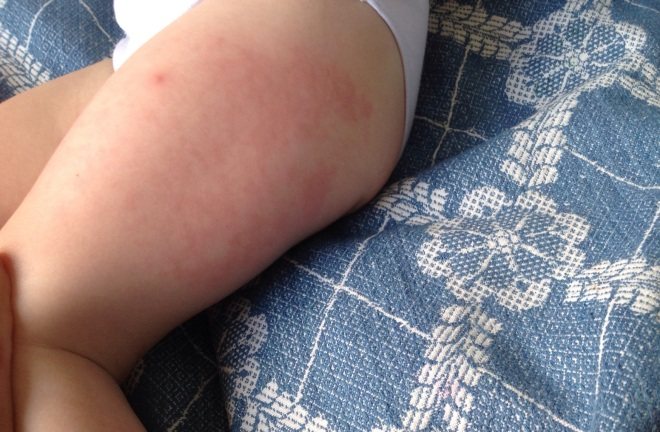
Tumor of the entire leg
A problem affecting the entire leg becomes a good reason to consult a pediatrician. Especially if accompanying symptoms have also developed: the temperature has become higher, diarrhea, heartburn, drowsiness and lethargy have appeared. During the first few days after the procedure, all of this may also be normal, but high body temperature and swelling that persist for five days often indicate complications.
It is important to pay attention to the characteristics of the tumor itself:
- pus, rash and unpleasant odor;
- a sharp deterioration in behavior, crying and irritability;
- rapid swelling of the entire leg, starting from the injection site.
In this case, we may be talking about a developing cold abscess and purulent infiltrate. This means that an infection was introduced into the skin puncture site, and purulent inflammation of the tissue began. It is better not to self-medicate in such a situation; you should immediately contact a surgeon. He will open and wash the wound, and then prescribe antibiotics.
It is also worth checking the baby for allergies; swelling can be a common manifestation of an allergic reaction.
If thickening and redness appear after DTP vaccination, what should you do?
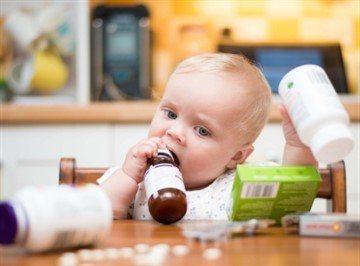
The main thing is not to panic. Parents should understand that each child reacts to the vaccine differently. Watch the baby. He must be cheerful and active, have a good appetite.
You can walk, but you should dress carefully, trying not to touch or squeeze the reddened injection site. Monitor reactions to the vaccine. Normally, redness at the puncture site can reach 8-10 cm in diameter. Take your time to start treatment; the redness should disappear on its own.
You just need to wait until the infiltrate resolves. If the baby complains about his foot and does not step on it, you can give him Paracetamol or Ibuprofen. If the child is bothered by pain at the injection site, a compress with Novocaine should be made. To do this, gauze is moistened in the solution and the lotion is carefully secured to the baby’s leg.
Among the folk methods, you can try a cabbage leaf compress. To do this, first knead it or tap it with a hammer so that the juice comes out. Then the sheet is wrapped around the sore spot and fixed until it dries completely. Cabbage juice effectively relieves inflammation and redness.
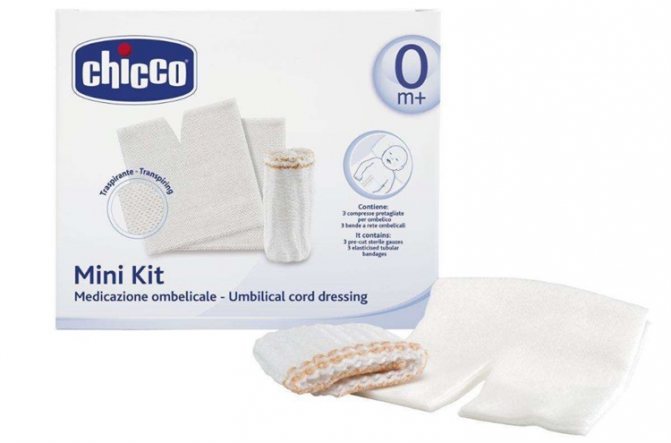
Sometimes doctors advise using a vodka compress. It is done simply: gauze (or cotton cloth) is moistened in alcohol and applied to the reddened area. After 2 hours, the application is changed to a fresh one. And so on all day.
Keep an eye on your baby at all times. He should not be allowed to scratch the injection site. Dress the child so that he cannot reach the sore area. Tight pants or tights should be avoided.
Clothing should be loose and not put pressure on the inflamed area. You should not heat the injection site, even if the redness seems too great to you. This can cause an abscess.
Remember that both redness and thickening during the post-injection period are normal if the child feels well.
Swelling after DTP vaccination - what to do
There are various remedies that can help if a child’s leg is swollen after DPT. Lumps that appear after vaccination often cause discomfort, but they can be dealt with.
Ointments and gels
Troxevasin gel is first aid if the body temperature begins to reach 39 °C. In the fight against adverse reactions, you can also make a lotion with novocaine and pay attention to antipyretics. Nurofen or Paracetamol can help with this problem, the latter can also be used as a rectal suppository.
If these remedies do not help, you can try others.
- For the consequences of an allergic reaction, it is worth giving an antihistamine, which is selected depending on age. Fenistil in drops is good to use for infants, from the age of one year - Zirtrek, and after two years - Claritin.
- Aescusan and Troxerutin are ointments for quick healing. Rescuer will help in the fight against inflammation.
- Heparin ointment saves from edema of any kind, increasing microcirculation in tissues.
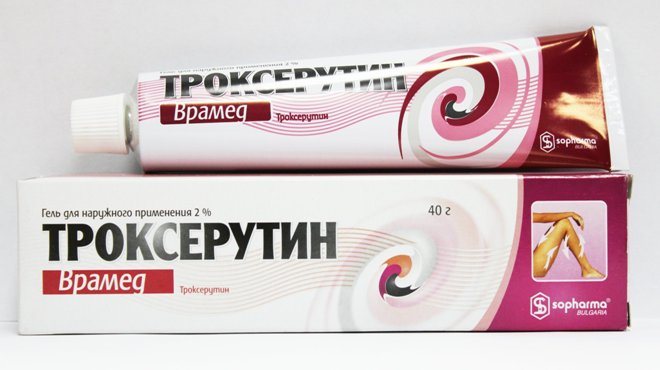
Any of these medications will definitely help in the fight against symptoms that appear after vaccination.
Folk recipes
Often parents try to help their child using traditional methods. Such compresses can really cope with inflammation.
- Cottage cheese compress. The cottage cheese needs to be heated, wrapped in gauze and kept at the injection site until it cools completely.
- Honey cake compress. Honey needs to be mixed with yolk and butter, make a flat cake from the resulting mass and keep it on the seal. A compress of honey and flour has the same effect.
- The cabbage leaf does not require any preparatory work - just apply it overnight.
- Soda lotion. The fabric should be soaked in a solution of soda and applied to the problem area.
When using each of these folk remedies, you need to remember that any non-breathable materials are prohibited - this can only worsen the inflammatory effect.
What medications should not be given after vaccination?
It is best to give vaccinations when the child is completely healthy and not taking any medications. But, in general, DPT is compatible with most medications. It is worth completely excluding only vitamin D, which may be prescribed in connection with developing rickets, and when choosing antihistamines, it is better to avoid Tavegil and Suprastin due to drying of the mucous membranes. Otherwise, there are no contraindications to taking medications.
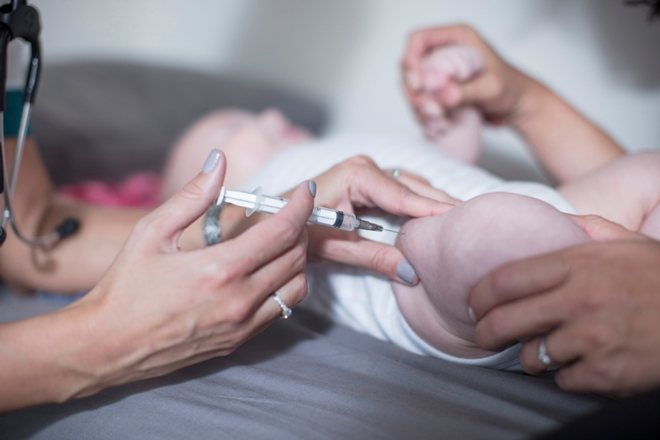
How to treat the injection site if it is inflamed and burning?
If the redness is too severe, you should apply Troxevasin ointment . The active components in the product cope well with inflammation. It is recommended to use the ointment twice a day.
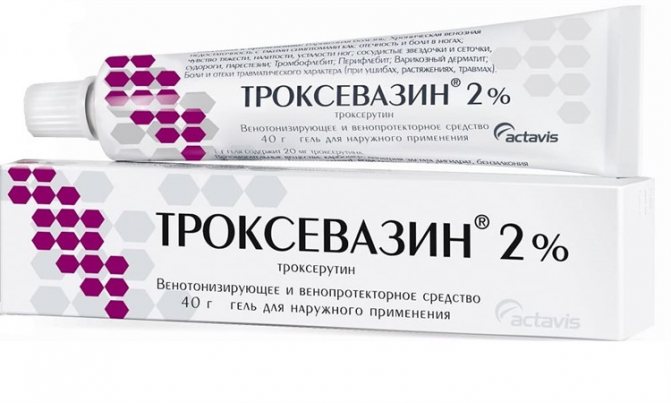
Troxevasin ointment
It is carefully applied to the redness in a small layer (until completely absorbed). Contraindications to the ointment include: allergies to the components of the product and dermatitis.
Often, the next day after using the product, you can see a small bump instead of redness and swelling. This is fine. This is how Troxevasin fights compaction, if there is one.
Help your baby prevent it with antiviral drugs. Vaccination has weakened the child’s immunity, and he can easily catch the flu. If the first signs of ARVI are noticed, Viferon gel is well suited.
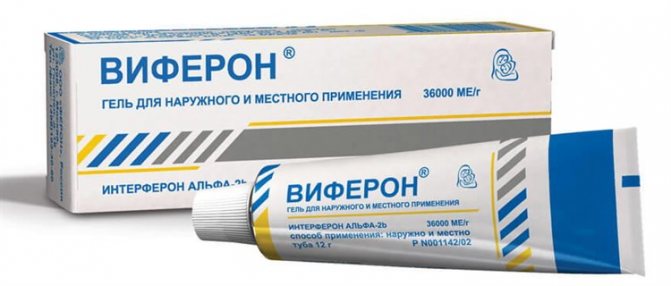
Gel Viferon
The following will help relieve redness, allergic itching and alleviate the condition of the baby:
- Fenistil (drops). For babies over one year old – 5 drops of Zyrtec (twice a day);
- Children over 2 years old will benefit from Claritin (syrup) 1 tsp. in a day;
- Heparin ointment and Troxerutin (gel) will improve blood circulation and relieve swelling.
Visit your pediatrician every 2 days until the redness disappears completely.
What to do if the redness grows and thickens?

Any ointments or compresses (without consultation with the pediatrician) can aggravate the situation. If the redness continues to increase, and the injection site becomes more and more dense and painful, it means that the vaccination was carried out incorrectly.
Most likely, the wound got infected. This is dangerous due to the development of an abscess (accumulation of pus in the infiltrate). But the reason may also be individual intolerance to the composition of the vaccine. To prevent this from happening, the baby must be thoroughly examined before immunization and be absolutely healthy at the time of vaccination.
What are the signs of an abscess? They are as follows:
- tissue softening is felt in the compaction;
- in the center of the abscess the skin becomes thinner. Therefore, an abscess can open on its own if it is located superficially;
- the skin in the affected area is bright red and hot;
- body temperature from 39 and above;
- throbbing pain at the site of swelling.
Such compaction will not go away on its own. He needs to be operated on, which means contacting a surgeon. If the doctor only suspects the presence of an abscess, the baby is given an ultrasound. The danger of a post-vaccination abscess is that it can break out on its own at any time.
Then the pus will enter the closed cavities and spread the infection throughout the body. After surgery, the baby is prescribed antibacterial drugs.
To prevent such situations from happening, parents should prepare for vaccination. You should find out in advance the quality of the drug offered by the clinic.
And if in doubt, purchase the vaccine yourself. It is equally important to prepare your baby for vaccination.
The day before (two days before the procedure) and after it, protect your child from negative psycho-emotional moments. It is very important that the child does not get sick on the day of vaccination, this will weaken his immunity, and vaccination may be difficult.
Be sure to make sure that the baby has no contraindications to the administered drug. If the preparation is carried out correctly and the injection is done correctly, there is nothing to fear.

